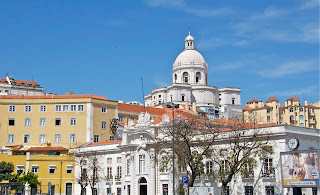In an earlier post I mentioned that Ruth and I walked from our hotel to the National Tile Museum (Museu Nacional do Azulejo), about 3.5 Km. It was a sunny and very warm day without much shade along the busy Avenida Infante Dom Henrique (Avenue Prince Henry), through the dock area and then past the metro rail yards to get to the Convent of Madre-de-Deus where the museum is housed.
Before the photos from the museum, I have included photos of a couple of things we saw along our walk to the museum.
The first photo is the dome of the National Pantheon (about which more later) and the second is an unusual building with complex colourful tile exterior and an odd square cupola-like affair perched on the top.
This is a photo of Ruth walking on a narrow sidewalk beside a road that we thought would take us under the highway bridge (on the left of the photo), and continue on to the museum. But this particular walkway pretty much ended under the bridge. As we were looking at our map trying to figure out how to get out of there, a workman saw us and came to our rescue. He spoke excellent English and told us that we actually had to walk on the bridge.
So, we went back to the beginning of the bridge and here is Ruth walking up the narrow bridge walkway, beside quite heavy traffic, which would take us across the railway tracks and so to the street which took us to the museum.
Now on to the tile museum.
The Convent of Madre-de-Deus was founded by queen Lenora in 1509 and it contains examples of the history of sacred art as well as the azulejo museum. The Igreja de Madre de Deus, said to be one of the most beautiful churches in Lisboa, is within the confines of the convent buildings. The church is decorated with gilded wood carvings, paintings and blue and white tiles from Holland, like those in the photo of the stairway up to the second floor shown below.
The photo above and this one show the garden area in front of the entrance to the museum.
And this is, obviously, inside the church. Not sure about the validity of claim to be the most beautiful church in Lisboa; but if you look carefully you can see the blue and white tiles in places along the walls. Not a great photo but it was, as usual, quite dark inside the church and I didn't have a tripod, so some unavoidable camera shake causes blurring.
Initially the Tile Museum was a part of the museum of ancient art but in 1980 it achieved the status of a national museum and the following years have been spent in organizing, researching and recording the history of this unique Portuguese art form which now includes both ancient and contemporary styles. The museum shows how the 5000 year old art evolved in Portugal from glazed tiles of Granada and other forms of Arab-Hispanic tile art to the current day, demonstrating the evolution of techniques of manufacture.
It won't surprise you if I tell you that I have many more photos of tile patterns - I have included only a few samples here to give some idea of the range of designs varying from a abstract images like the one just above, to repetitive patterns, like the one to the right, to the picture of the potter below - and including stories as in the last two photos.
This one appears to represent a number of activities going on in a town (this may be a special event in a particular town but I didn't make note of the details about it) and the last photo is a series of panels depicting the tale of how a young man from a rural area went to the city where he learned the craft of the milliner or hat maker. There are a couple more samples of tile museum panels in Lisboa 3.
I have been interested in azulejos since John Wheeler drew my attention to them a few years ago and I have talked about them in blog post in 2010 - see More than you wanted to know
The Museu Nacional do Azulejos is in a very attractive setting and has an unexpectedly friendly ambiance. It is extremely well organized, the tile art is beautifully presented and the descriptions of the history very informative and easily accessed with the assistance of a self guided tour which has formats available for people with special needs. It was definitely a highlight of our visit to Lisboa this year.
Thursday, April 21, 2011
Subscribe to:
Post Comments (Atom)













No comments:
Post a Comment